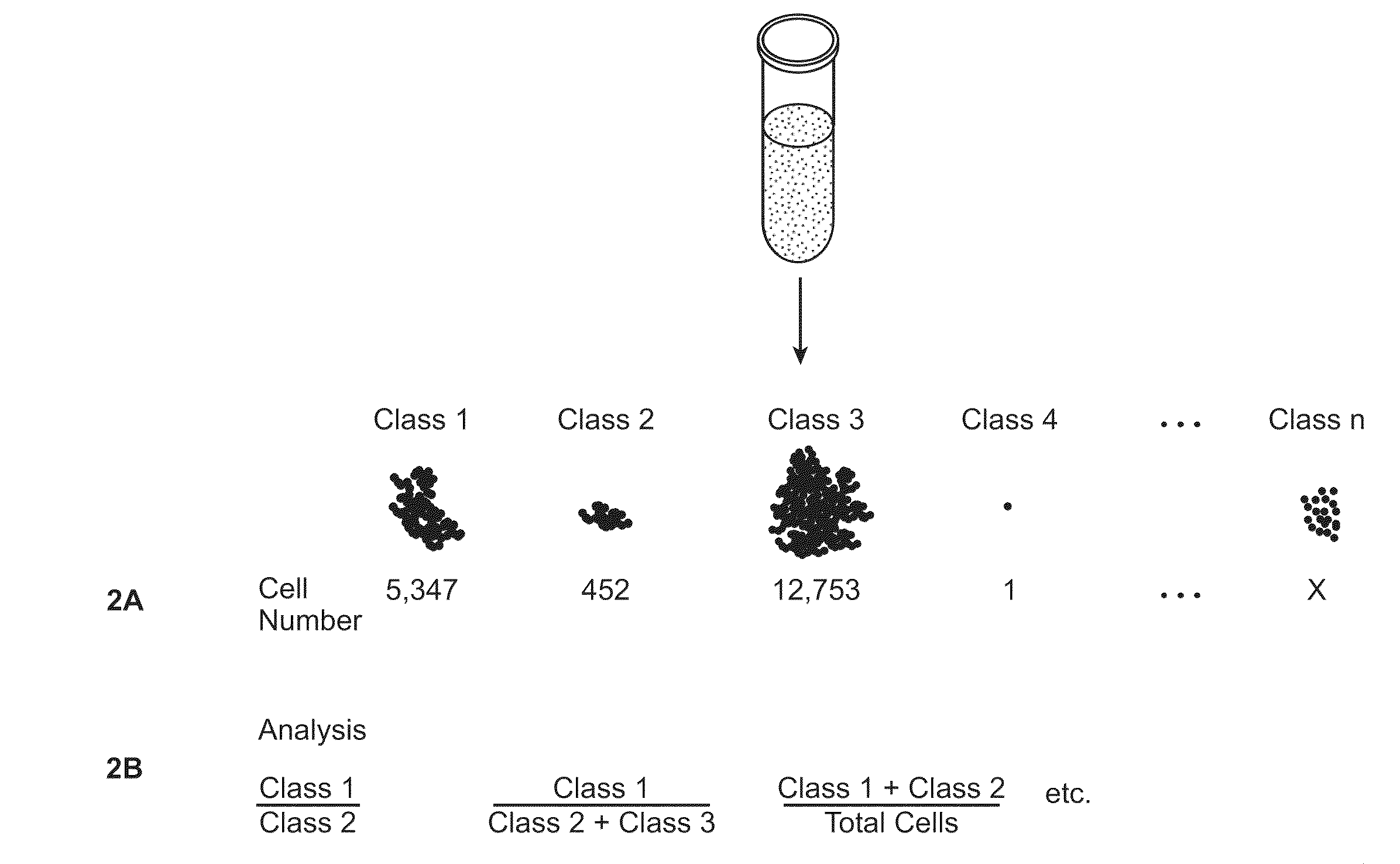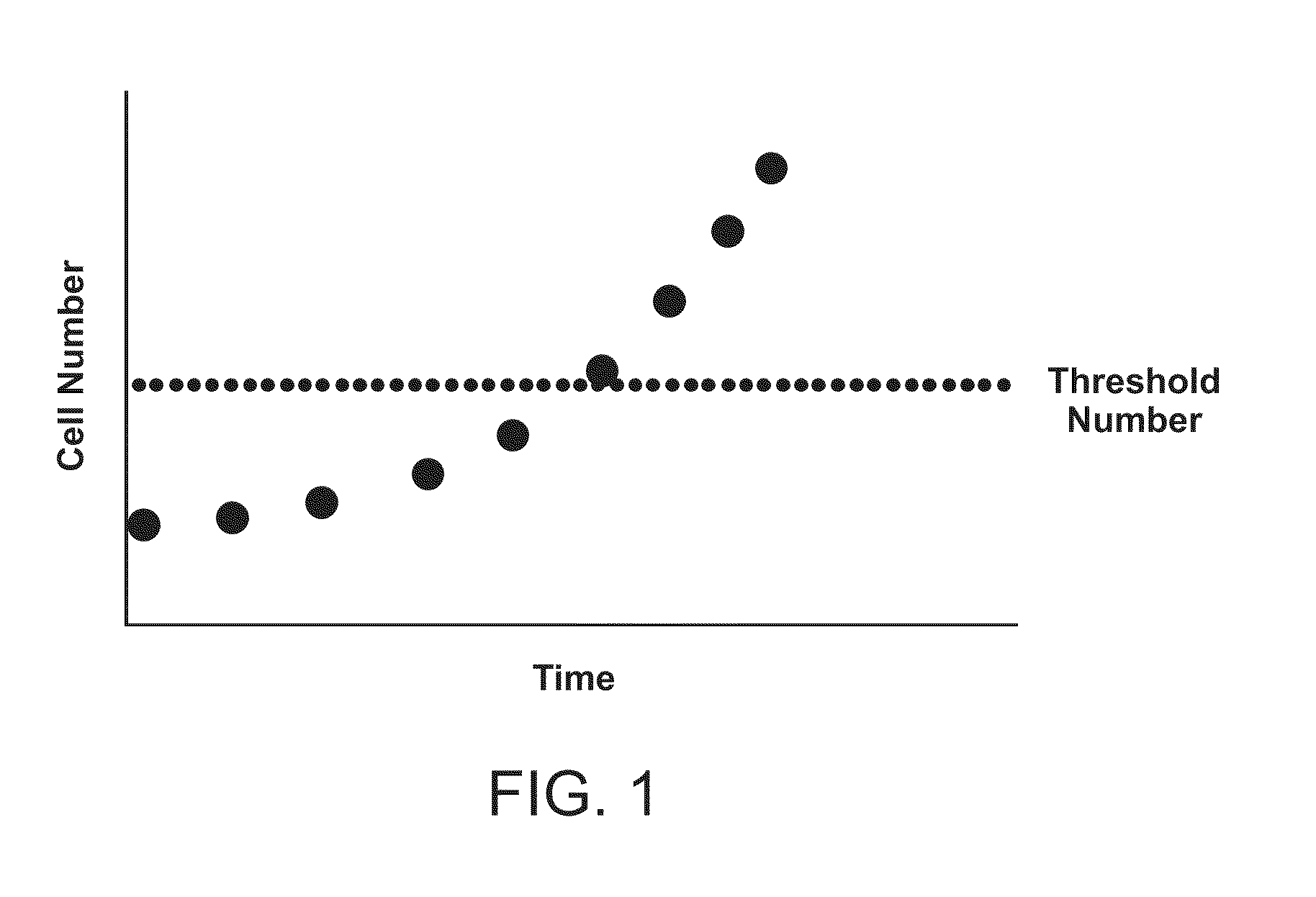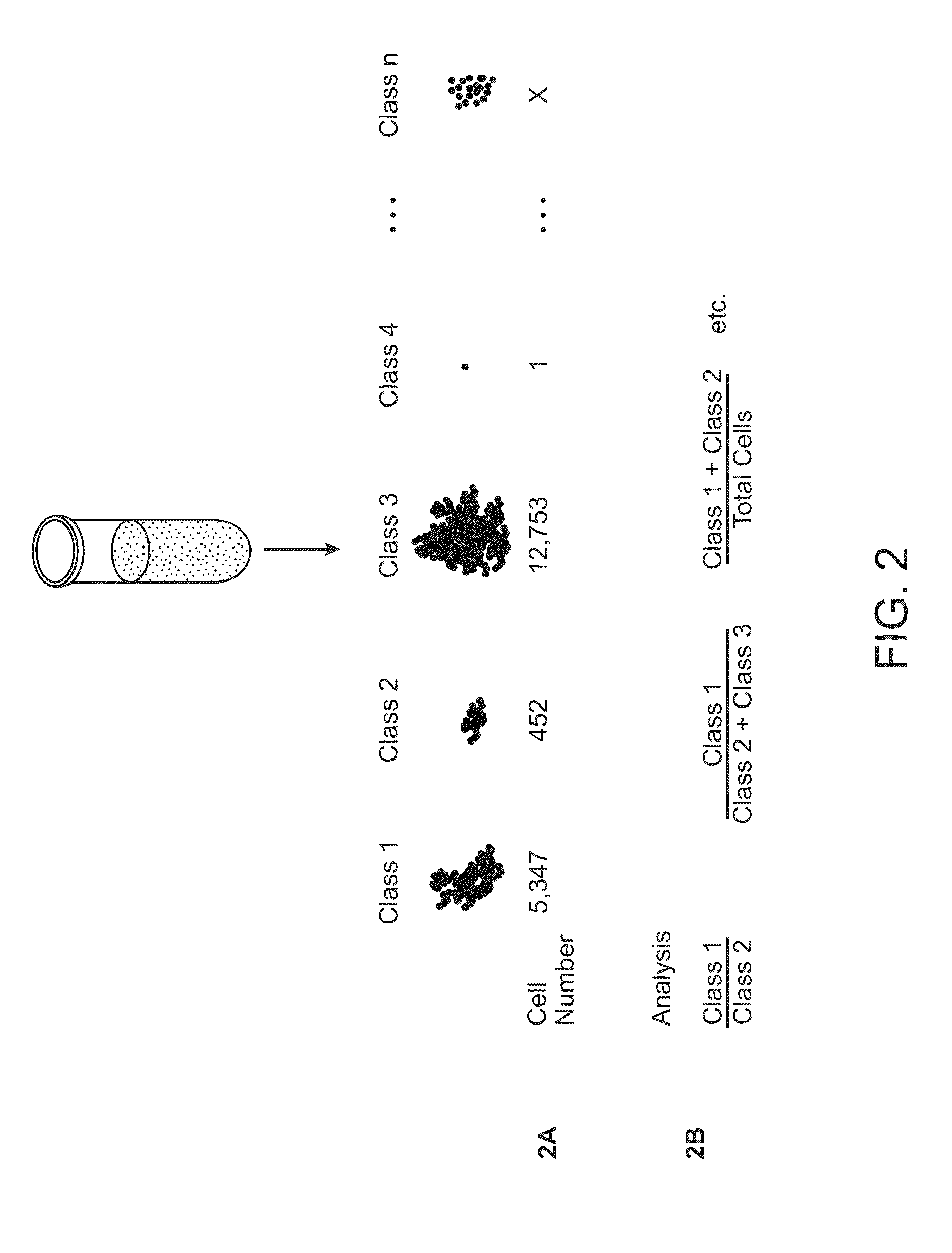[0042]In some embodiments, the protein is selected from the group consisting of kinases, phosphatases, lipid signaling molecules, adaptor / scaffold proteins, cytokines, cytokine regulators, ubiquitination enzymes, adhesion molecules, cytoskeletal proteins, heterotrimeric G proteins, small molecular weight GTPases, guanine nucleotide exchange factors, GTPase activating proteins, caspases, proteins involved in apoptosis, cell cycle regulators, molecular chaperones, metabolic enzymes, vesicular transport proteins, hydroxylases, isomerases, deacetylases, methylases, demethylases, tumor suppressor genes, proteases, ion channels, molecular transporters, transcription factors / DNA binding factors, regulators of transcription, and regulators of translation.
[0043]In some embodiments, the protein is selected from the group consisting of HER receptors, PDGF receptors, Kit receptor, FGF receptors, Eph receptors, Trk receptors, IGF receptors, Insulin receptor, Met receptor, Ret, VEGF receptors, TIE1, TIE2, FAK, Jak1, Jak2, Jak3, Tyk2, Src, Lyn, Fyn, Lck, Fgr, Yes, Csk, Abl, Btk, ZAP70, Syk, IRAKs, cRaf, ARaf, BRAF, Mos, Lim kinase, ILK, Tpl, ALK, TGFβ receptors, BMP receptors, MEKKs, ASK, MLKs, DLK, PAKs, Mek 1, Mek 2, MKK3 / 6, MKK4 / 7, ASK1, Cot, NIK, Bub, Myt 1, Wee1, Casein kinases, PDK1, SGK1, SGK2, SGK3, Akt1, Akt2, Akt3, p90Rsks, p70S6Kinase, Prks, PKCs, PKAs, ROCK 1, ROCK 2, Auroras, CaMKs, MNKs, AMPKs, MELK, MARKs, Chk1, Chk2, LKB-1, MAPKAPKs, Pim1, Pim2, Pim3, IKKs, Cdks, Jnks, Erks, IKKs, GSK3α, GSK3β, Cdks, CLKs, PKR, PI3-Kinase class 1, class 2, class 3, mTor, SAPK / JNK1,2,3, p38s, PKR, DNA-PK, ATM, ATR, Receptor protein tyrosine phosphatases (RPTPs), LAR phosphatase, CD45, Non receptor tyrosine phosphatases (NPRTPs), SHPs, MAP kinase phosphatases (MKPs), Dual Specificity phosphatases (DUSPs), CDC25 phosphatases, Low molecular weight tyrosine phosphatase, Eyes absent (EYA) tyrosine phosphatases, Slingshot phosphatases (SSH), serine phosphatases, PP2A, PP2B, PP2C, PP1, PP5, inositol phosphatases, PTEN, SHIPs, myotubularins, phosphoinositide kinases, phopsholipases, prostaglandin synthases, 5-lipoxygenase, sphingosine kinases, sphingomyelinases, adaptor / scaffold proteins, Shc, Grb2, BLNK, LAT, B cell adaptor for PI3-kinase (BCAP), SLAP, Dok, KSR, MyD88, Crk, CrkL, GAD, Nck, Grb2 associated binder (GAB), Fas associated death domain (FADD), TRADD, TRAF2, RIP, T-Cell leukemia family, IL-2, IL-4, IL-8, IL-6, interferon γ, interferon α, suppressors of cytokine signaling (SOCs), Cbl, SCF ubiquitination ligase complex, APC / C, adhesion molecules, integrins, Immunoglobulin-like adhesion molecules, selectins, cadherins, catenins, focal adhesion kinase, p130CAS, fodrin, actin, paxillin, myosin, myosin binding proteins, tubulin, eg5 / KSP, CENPs, β-adrenergic receptors, muscarinic receptors, adenylyl cyclase receptors, small molecular weight GTPases, H-Ras, K-Ras, N-Ras, Ran, Rac, Rho, Cdc42, Arfs, RABs, RHEB, Vav, Tiam, Sos, Dbl, PRK, TSC1,2, Ras-GAP, Arf-GAPs, Rho-GAPs, caspases, Caspase 2, Caspase 3, Caspase 6, Caspase 7, Caspase 8, Caspase 9, Bcl-2, Mcl-1, Bcl-XL, Bcl-w, Bcl-B, Al, Bax, Bak, Bok, Bik, Bad, Bid, Bim, Bmf, Hrk, Noxa, Puma, IAPs, XIAP, Smac, Cdk4, Cdk 6, Cdk 2, Cdk1, Cdk 7, Cyclin D, Cyclin E, Cyclin A, Cyclin B, Rb, p16, p14Arf, p27KIP, p21CIP, molecular chaperones, Hsp90s, Hsp70, Hsp27, metabolic enzymes, Acetyl-CoAa Carboxylase, ATP citrate lyase, nitric oxide synthase, caveolins, endosomal sorting complex required for transport (ESCRT) proteins, vesicular protein sorting (Vsps), hydroxylases, prolyl-hydroxylases PHD-1, 2 and 3, asparagine hydroxylase FIH transferases, Pin1 prolyl isomerase, topoisomerases, deacetylases, Histone deacetylases, sirtuins, histone acetylases, CBP / P300 family, MYST family, ATF2, DNA methyl transferases, Histone H3K4 demethylases, H3K27, JHDM2A, UTX, VHL, WT-1, p53, Hdm, PTEN, ubiquitin proteases, urokinase-type plasminogen activator (uPA) and uPA receptor (uPAR) system, cathepsins, metalloproteinases, esterases, hydrolases, separase, potassium channels, sodium channels, multi-drug resistance proteins, P-Gycoprotein, nucleoside transporters, Ets, Elk, SMADs, Rel-A (p65-NFKB), CREB, NFAT, ATF-2, AFT, Myc, Fos, Sp1, Egr-1, T-bet, β-catenin, HIFs, FOXOs, E2Fs, SRFs, TCFs, Egr-1, β-catenin, FOXO STAT1, STAT 3, STAT 4, STAT 5, STAT 6, p53, WT-1, HMGA, pS6, 4EPB-1, eIF4E-binding protein, RNA polymerase, initiation factors, and elongation factors. In some embodiments, the protein is selected from the group consisting of Erk, Syk, Zap70, Lyn, Btk, BLNK, Cbl, PLCγ2, Akt, RelA, p38, S6. In some embodiments, the protein is S6.
[0044]In some embodiments, the activation level is determined by a process comprising the binding of a binding element which is specific to a particular activation state of the particular activatable element. In some embodiments, the binding element comprises a protein. In some embodiments, the protein is an antibody. In some embodiments, the antibody binds to a activatable element selected from the group consisting of kinases, phosphatases, adaptor / scaffold proteins, ubiquitination enzymes, adhesion molecules, contractile proteins, cytoskeletal proteins, heterotrimeric G proteins, small molecular weight GTPases, guanine nucleotide exchange factors, GTPase activating proteins, caspases and proteins involved in apoptosis, ion channels, molecular transporters, molecular chaperones, metabolic enzymes, vesicular transport proteins, hydroxylases, isomerases, transferases, deacetylases, methylases, demethylases, proteases, esterases, hydrolases, DNA binding proteins and transcription factors.
[0045]In some embodiments, the antibody binds to an activatable element selected from the group consisting of HER receptors, PDGF receptors, Kit receptor, FGF receptors, Eph receptors, Trk receptors, IGF receptors, Insulin receptor, Met receptor, Ret, VEGF receptors, TIE1, TIE2, FAK, Jak1, Jak2, Jak3, Tyk2, Src, Lyn, Fyn, Lck, Fgr, Yes, Csk, Abl, Btk, ZAP70, Syk, IRAKs, cRaf, ARaf, BRAF, Mos, Lim kinase, ILK, Tpl, ALK, TGFβ receptors, BMP receptors, MEKKs, ASK, MLKs, DLK, PAKs, Mek 1, Mek 2, MKK3 / 6, MKK4 / 7, ASK1, Cot, NIK, Bub, Myt 1, Wee1, Casein kinases, PDK1, SGK1, SGK2, SGK3, Akt1, Akt2, Akt3, p90Rsks, p70S6Kinase, Prks, PKCs, PKAs, ROCK 1, ROCK 2, Auroras, CaMKs, MNKs, AMPKs, MELK, MARKs, Chk1, Chk2, LKB-1, MAPKAPKs, Pim1, Pim2, Pim3, IKKs, Cdks, Jnks, Erks, IKKs, GSK3a, GSK3β, Cdks, CLKs, PKR, PI3-Kinase class 1, class 2, class 3, mTor, SAPK / JNK1,2,3, p38s, PKR, DNA-PK, ATM, ATR, Receptor protein tyrosine phosphatases (RPTPs), LAR phosphatase, CD45, Non receptor tyrosine phosphatases (NPRTPs), SHPs, MAP kinase phosphatases (MKPs), Dual Specificity phosphatases (DUSPs), CDC25 phosphatases, Low molecular weight tyrosine phosphatase, Eyes absent (EYA) tyrosine phosphatases, Slingshot phosphatases (SSH), serine phosphatases, PP2A, PP2B, PP2C, PP1, PP5, inositol phosphatases, PTEN, SHIPs, myotubularins, phosphoinositide kinases, phopsholipases, prostaglandin synthases, 5-lipoxygenase, sphingosine kinases, sphingomyelinases, adaptor / scaffold proteins, Shc, Grb2, BLNK, LAT, B cell adaptor for PI3-kinase (BCAP), SLAP, Dok, KSR, MyD88, Crk, CrkL, GAD, Nck, Grb2 associated binder (GAB), Fas associated death domain (FADD), TRADD, TRAF2, RIP, T-Cell leukemia family, IL-2, IL-4, IL-8, IL-6, interferon γ, interferon α, suppressors of cytokine signaling (SOCs), Cbl, SCF ubiquitination ligase complex, APC / C, adhesion molecules, integrins, Immunoglobulin-like adhesion molecules, selectins, cadherins, catenins, focal adhesion kinase, p130CAS, fodrin, actin, paxillin, myosin, myosin binding proteins, tubulin, eg5 / KSP, CENPs, β-adrenergic receptors, muscarinic receptors, adenylyl cyclase receptors, small molecular weight GTPases, H-Ras, K-Ras, N-Ras, Ran, Rac, Rho, Cdc42, Arfs, RABs, RHEB, Vav, Tiam, Sos, Dbl, PRK, TSC1,2, Ras-GAP, Arf-GAPs, Rho-GAPs, caspases, Caspase 2, Caspase 3, Caspase 6, Caspase 7, Caspase 8, Caspase 9, Bcl-2, Mcl-1, Bcl-XL, Bcl-w, Bcl-B, Al, Bax, Bak, Bok, Bik, Bad, Bid, Bim, Bmf, Hrk, Noxa, Puma, IAPs, XIAP, Smac, Cdk4, Cdk 6, Cdk 2, Cdk1, Cdk 7, Cyclin D, Cyclin E, Cyclin A, Cyclin B, Rb, p16, p14Arf, p27KIP, p21CIP, molecular chaperones, Hsp90s, Hsp70, Hsp27, metabolic enzymes, Acetyl-CoAa Carboxylase, ATP citrate lyase, nitric oxide synthase, caveolins, endosomal sorting complex required for transport (ESCRT) proteins, vesicular protein sorting (Vsps), hydroxylases, prolyl-hydroxylases PHD-1, 2 and 3, asparagine hydroxylase FIH transferases, Pin1 prolyl isomerase, topoisomerases, deacetylases, Histone deacetylases, sirtuins, histone acetylases, CBP / P300 family, MYST family, ATF2, DNA methyl transferases, Histone H3K4 demethylases, H3K27, JHDM2A, UTX, VHL, WT-1, p53, Hdm, PTEN, ubiquitin proteases, urokinase-type plasminogen activator (uPA) and uPA receptor (uPAR) system, cathepsins, metalloproteinases, esterases, hydrolases, separase, potassium channels, sodium channels, multi-drug resistance proteins, P-Gycoprotein, nucleoside transporters, Ets, Elk, SMADs, Rel-A (p65-NFKB), CREB, NFAT, ATF-2, AFT, Myc, Fos, Sp1, Egr-1, T-bet, β-catenin, HIFs, FOXOs, E2Fs, SRFs, TCFs, Egr-1, β-catenin, FOXO STAT1, STAT 3, STAT 4, STAT 5, STAT 6, p53, WT-1, HMGA, pS6, 4EPB-1, eIF4E-binding protein, RNA polymerase, initiation factors, and elongation factors.
[0046]In some embodiments, the step of determining the activation level comprises the use of flow cytometry, immunofluorescence, confocal microscopy, immunohistochemistry, immunoelectronmicroscopy, nucleic acid amplification, gene array, protein array, mass spectrometry, patch clamp, 2-dimensional gel electrophoresis, differential display gel electrophoresis, microsphere-based multiplex protein assays, ELISA, and label-free cellular assays to determine the activation level of one or more intracellular activatable element in single cells. In some embodiments, the determining step comprises the use of flow cytometry.
[0047]In some embodiments, determining the presence or absence of the disease-associated cells is further based on the presence or absence of one or more cell surface markers, the presence or absence of one or more intracellular markers, or a combination thereof.
 Login to View More
Login to View More 


